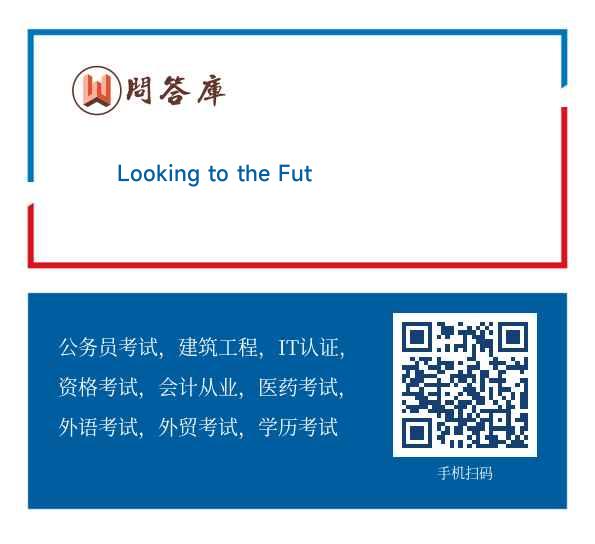Looking to the FutureWhen a magazine for high-
问题详情
Looking to the Future
When a magazine for high-school students asked its readers what life would be like in twenty years, they said: Machines would be run by solar power. Buildings would rotate so they could follow the sun to take maximum advantage of its light and heat. Walls would "radiate light" and "change color with the push of a button". Food would be replaced by pills. (1) Cars would have radar. Does this sound like the year 2000? (2) .
The future is much too important to simply guess about, the way the high school students did, so experts are regularly asked to predict accurately. (3) But can they? One expert on cities wrote: cities of the future would not be crowded, but would have space for farms and fields. People would travel to work in "airbuses", large all-weather helicopters carrying up to 200 passengers. When a person left the airbus station he could drive a coin-operated car equipped with radar. The radar equipment of cars would make traffic accidents "almost unheard of". Does that sound familiar? If the expert had been accurate it would, because he was writing in 1957, his subject was "The city of 1982".
If the professionals sometimes sound like high-school students, it&39;s probably because future study is still a new field. But economic forecasting, or predicting what the economy will do, has been around for a long time. It should be accurate, and generally it is. But there have been some big mistakes in this field, too. (4) In October of that year, the stock market had its worst losses ever, mining thousands of investors who had put their faith in financial foreseers.
(5) In 1957, H. J. Rand of the Rad Corporation was asked about the year 2000, "Only one thing is certain," he answered. "Children will have reached the age of 43."
(1)
??A. By carefully studying the present, skilled businessmen scientists, and politicians are supposedly able to figure out in advance what will happen.B. School would be taught "by electrical impulse while we sleep."C. One forecaster knew that predictions about the future would always be subject to significant errors.D. In early 1929, most forecasters saw an excellent future for the stock market.E. Everyone may look to the future for it is always promising.F. Actually, the article was written in 1958 and the question was, "what will life be like in 19787"??
(2)
??A. By carefully studying the present, skilled businessmen scientists, and politicians are supposedly able to figure out in advance what will happen.B. School would be taught "by electrical impulse while we sleep."C. One forecaster knew that predictions about the future would always be subject to significant errors.D. In early 1929, most forecasters saw an excellent future for the stock market.E. Everyone may look to the future for it is always promising.F. Actually, the article was written in 1958 and the question was, "what will life be like in 19787"??
(3)
A. By carefully studying the present, skilled businessmen scientists, and politicians are supposedly able to figure out in advance what will happen.
B. School would be taught "by electrical impulse while we sleep."
C. One forecaster knew that predictions about the future would always be subject to significant errors.
D. In early 1929, most forecasters saw an excellent future for the stock market.
E. Everyone may look to the future for it is always promising.
F. Actually, the article was written in 1958 and the question was, "what will life be like in 19787"
(4)
A. By carefully studying the present, skilled businessmen scientists, and politicians are supposedly able to figure out in advance what will happen.
B. School would be taught "by electrical impulse while we sleep."
C. One forecaster knew that predictions about the future would always be subject to significant errors.
D. In early 1929, most forecasters saw an excellent future for the stock market.
E. Everyone may look to the future for it is always promising.
F. Actually, the article was written in 1958 and the question was, "what will life be like in 19787"
(5)
A. By carefully studying the present, skilled businessmen scientists, and politicians are supposedly able to figure out in advance what will happen.
B. School would be taught "by electrical impulse while we sleep."
C. One forecaster knew that predictions about the future would always be subject to significant errors.
D. In early 1929, most forecasters saw an excellent future for the stock market.
E. Everyone may look to the future for it is always promising.
F. Actually, the article was written in 1958 and the question was, "what will life be like in 19787"请帮忙给出每个问题的正确答案和分析,谢谢!
参考答案
问题 1 答案解析:
B;空格前后句都在举例,而且时态结构都是“would+/,因此B最合适:在内容上举例,而且在时态上呼应。
问题 2 答案解析:F
F;空格前句出现疑问句,因此接下来在空格处出现另一个问题或对前面的问题进行回答的可能性较大,而且F中的“the article”与前文内容呼应——“当一本面向中学生的杂志问它的读者。”
问题 3 答案解析:
A;空格前句提到“专家”,空格后句说到“他们”——指代专家的可能性较大,因此猜测空格处可能出现涉及到“专家”的内容描述,A中出现的“刘经商之道熟悉的商人、科学家、政治家”正是“专家”,所以A正确。
问题 4 答案解析:
D;空格后句中提到了“股票市场”。
问题 5 答案解析:
C; 空格后句是在进行具体列举了一个预测家所做的预测,因此空格处出现观点性、概括性的句子的可能性较大,C在用词上(one forecaster)恰好与空格后句中的具体人名(H.J.Rand)呼应,而且C(一位预测家知道预测未来总是容易发生人的错误)也正好是概括总结句,而且在句意上很好地解释了为什么H.工Rand说“只有一件事情是确定的,那就是现在出生的孩子在2000年时将是43岁。”
